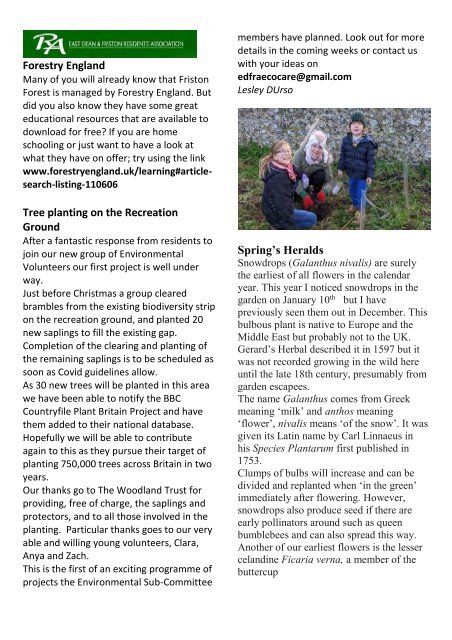East Dean 2021-02 web (1)
Welcome to the East Dean with Friston Parish magazine, keep in touch during these difficult times. Contact Christine if you wish to add any village content to the next publication eastdeanfristonmagazine@gmail.com
Welcome to the East Dean with Friston Parish magazine, keep in touch during these difficult times.
Contact Christine if you wish to add any village content to the next publication eastdeanfristonmagazine@gmail.com
Create successful ePaper yourself
Turn your PDF publications into a flip-book with our unique Google optimized e-Paper software.
Forestry England<br />
Many of you will already know that Friston<br />
Forest is managed by Forestry England. But<br />
did you also know they have some great<br />
educational resources that are available to<br />
download for free? If you are home<br />
schooling or just want to have a look at<br />
what they have on offer; try using the link<br />
www.forestryengland.uk/learning#articlesearch-listing-110606<br />
Tree planting on the Recreation<br />
Ground<br />
After a fantastic response from residents to<br />
join our new group of Environmental<br />
Volunteers our first project is well under<br />
way.<br />
Just before Christmas a group cleared<br />
brambles from the existing biodiversity strip<br />
on the recreation ground, and planted 20<br />
new saplings to fill the existing gap.<br />
Completion of the clearing and planting of<br />
the remaining saplings is to be scheduled as<br />
soon as Covid guidelines allow.<br />
As 30 new trees will be planted in this area<br />
we have been able to notify the BBC<br />
Countryfile Plant Britain Project and have<br />
them added to their national database.<br />
Hopefully we will be able to contribute<br />
again to this as they pursue their target of<br />
planting 750,000 trees across Britain in two<br />
years.<br />
Our thanks go to The Woodland Trust for<br />
providing, free of charge, the saplings and<br />
protectors, and to all those involved in the<br />
planting. Particular thanks goes to our very<br />
able and willing young volunteers, Clara,<br />
Anya and Zach.<br />
This is the first of an exciting programme of<br />
projects the Environmental Sub-Committee<br />
members have planned. Look out for more<br />
details in the coming weeks or contact us<br />
with your ideas on<br />
edfraecocare@gmail.com<br />
Lesley DUrso<br />
Spring’s Heralds<br />
Snowdrops (Galanthus nivalis) are surely<br />
the earliest of all flowers in the calendar<br />
year. This year I noticed snowdrops in the<br />
garden on January 10 th but I have<br />
previously seen them out in December. This<br />
bulbous plant is native to Europe and the<br />
Middle <strong>East</strong> but probably not to the UK.<br />
Gerard’s Herbal described it in 1597 but it<br />
was not recorded growing in the wild here<br />
until the late 18th century, presumably from<br />
garden escapees.<br />
The name Galanthus comes from Greek<br />
meaning ‘milk’ and anthos meaning<br />
‘flower’, nivalis means ‘of the snow’. It was<br />
given its Latin name by Carl Linnaeus in<br />
his Species Plantarum first published in<br />
1753.<br />
Clumps of bulbs will increase and can be<br />
divided and replanted when ‘in the green’<br />
immediately after flowering. However,<br />
snowdrops also produce seed if there are<br />
early pollinators around such as queen<br />
bumblebees and can also spread this way.<br />
Another of our earliest flowers is the lesser<br />
celandine Ficaria verna, a member of the<br />
buttercup<br />
family Ranunculaceae. Commonly known<br />
as Pilewort, a look at its tuberous roots will<br />
tell you why it got that name. The old<br />
Doctrine of Signatures recommended it as a<br />
medical treatment for piles. However, it’s<br />
worth noting that the leaves are toxic.<br />
It’s a lover of damp woodland paths, stream<br />
banks and ditches and can be a rather<br />
invasive weed in gardens. The glossy star<br />
shaped yellow flowers open in the sun, the<br />
leaves are rounded, heart-shaped on long<br />
stalks. Vast carpets of them cover the<br />
ground on the corner of Friston Forest<br />
opposite the church and pond and are a truly<br />
dazzling sight. As one of the earliest plants<br />
to flower they are an important nectar source<br />
for insect pollinators coming out of winter<br />
hibernation.<br />
“There’s a flower that shall be mine,<br />
’tis the little celandine”<br />
(William Wordsworth )<br />
Kate Frankland<br />
Our thanks to the Rotary: Signs of<br />
Hope<br />
Many snowdrops in gardens are in flower<br />
and bulbs including daffodils, tulips,<br />
hyacinths and irises are poking up their<br />
heads. Now is the time for hope for good<br />
things to come in our gardens and in the<br />
villages with hopefully a display of crocuses<br />
on the verges by the bus stops and down<br />
Gilberts Drive. The crocuses were donated<br />
by the Rotary Club of <strong>East</strong>bourne Sovereign<br />
and to bring further colour to our village the<br />
club has donated wildflower seeds to be<br />
planted in the grassy area on the south side<br />
of the recreation ground.<br />
Let us hope that warm weather, beautiful<br />
flowers and successful vaccinations will<br />
brighten our lives in the not too distant<br />
future!<br />
John Wilton, Community Chairman,<br />
Rotary Club of <strong>East</strong>bourne Sovereign<br />
I would like to say<br />
a big thank you to<br />
my friends from<br />
the Bowls Club<br />
who gave food so<br />
generously for the<br />
homeless. In such<br />
a short period of time, I was given bags and<br />
boxes containing a variety of foods. It was<br />
received with thanks by the volunteers who<br />
give food to the homeless at night on the<br />
Western lawns.<br />
Rita Laws<br />
Bookmark Volunteering<br />
I have been volunteering helping children<br />
with their reading online for the last six<br />
months, which I have thoroughly enjoyed.<br />
It is with a charity called Bookmark and I<br />
am currently helping children of frontline<br />
and key workers in London, Cambridge and<br />
Hastings. I am writing about Bookmark as I<br />
thought there may be some villagers who<br />
would enjoy being involved with this in the<br />
near future.<br />
There is very extensive training online, with<br />
an online interview, and although for a<br />
while training was on hold, if you check the<br />
Bookmark <strong>web</strong>site you will now see they<br />
are looking for volunteers once again. It’s so<br />
great that you can be helping children all<br />
over the country!<br />
As a Bookmark volunteer, you’ll help 5-8<br />
year olds learn to read so that they can<br />
succeed in school and beyond. You’ll book<br />
fun, flexible 30-minute reading sessions,<br />
around your schedule, all through the<br />
Bookmark app. Sessions take place<br />
virtually, through Bookmark’s secure<br />
online platform.<br />
www.bookmarkreading.org<br />
Jan Haydock





